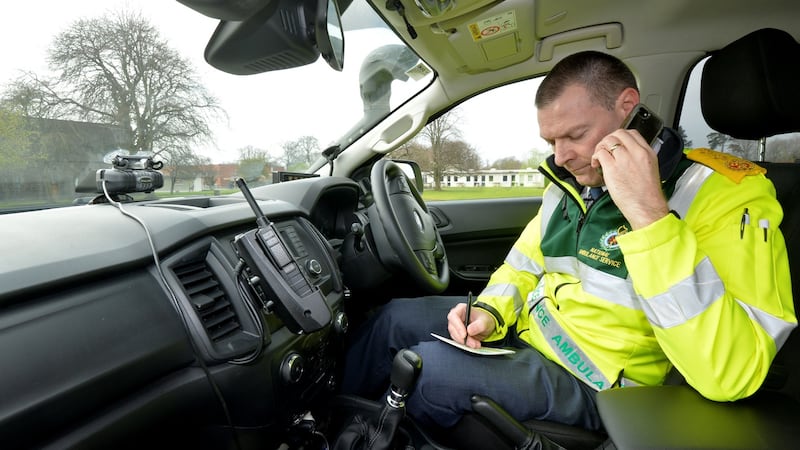In the headquarters of the National Ambulance Service for the north Leinster region, Richard Quinlan has a radio attached to his shirt, awaiting a call from the National Emergency Operations Centre.
While this is often normal procedure for paramedics, Mr Quinlan differs in that he is one of the 20 solo responders carrying out community at-home testing for coronavirus, also known as Covid-19.
People who are unwell and believe they have contracted the virus contact either their GP or the HSE hotline and are assessed by physicians over the phone to determine if they qualify for home-testing.
Once it is confirmed the patient should be tested, the operations centre looks at which testing vehicle is the closest to the call and sends a notification to that driver.
Preparing to attend a call, Mr Quinlan, the chief ambulance officer in north Leinster, gets into his Ford Ranger, which is stocked with medical equipment, including standard medications and a defibrillator.
Reassuring
In the boot of his vehicle, there are also 10 sets of three packages for testing for coronavirus. Each set contains a testing kit, which includes a vial, swab and tissues, a personal protective equipment kit for the tester, and an information pack for the patient.
Once the tester arrives at the address, he or she parks roughly about 1km away from the house so they have time to prepare the paperwork and ring the patient.
“It’s all about building a rapport and reassuring the person. We ring them first and introduce ourselves so they can get used to hearing our voice,” Mr Quinlan said.
“Then we ask them some questions. We ask if there are dogs or cats in the house, we don’t need them knocking over the testing kit or anything like that; if there are other people in the house; if they have facilities where we can prep our protective equipment in the hallway.”

He added: “A lot of it as well is to reassure the patient – to say that we know what we’re doing, we’re well capable of what we’re doing. It’s a step down process.”
Patients are asked to leave the doors in their house ajar so the tester can then enter without having to touch any door knobs.
The tester dresses in protective clothing, which includes using hand gel, an apron, two pairs of gloves, a mask and goggles, in the hallway, before entering the room the patient is in.
A clinical assessment of the individual is carried out first, to see if they are well enough to stay at home. The premises are then examined to determine if it is suitable for self-isolation.
Contingency plans
Once those two steps are completed, the actual test is carried out, during which the patient’s throat and nose are swabbed. The vial containing the sample is then bagged before being put in a box, to be sent off for testing.
The test takes roughly an hour from start to finish, and each vehicle can carry out between 16 and 18 tests a day, Mr Quinlan says.
More than 400 at-home tests were carried out during the first five days of the programme.
“We have escalated it very quickly and we are still running our day-to-day business. If it does escalate further, we have contingency plans and strategies to deal with call volume where we put on extra call-takers, dispatchers, managers,” Mr Quinlan said.
“We can ramp it up very quickly if we need to and the same applies if it goes away at short notice. We can bring it back down. The national ambulance has over 2,000 commissions on the road, all qualified as paramedics, advanced paramedics and EMTs and they would be quite capable and quite confident should the need arise.”
Once the paramedic has concluded the test, they return to the hallway to remove the protective clothing and place it in a clinical waste bag, which will be disposed of in official facilities.
They then return to the vehicle and deliver the sample into the nearest acute hospital, before it is transferred to the National Virus Reference Laboratory in UCD.
Mr Quinlan said it currently takes between 24 and 36 hours between the sample being taken and the results being delivered to the patient.
Despite the shocking image of someone wearing protective clothing arriving at your house, Mr Quinlan said most patients are relieved to see them.
“We always say that it looks worse than it is. And in general, the feedback is that they were delighted you’ve been there to test them. They’re happy to see you.”









